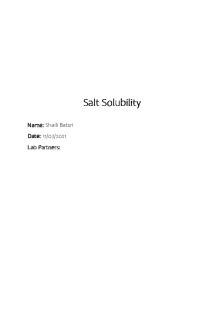Sand & Salt Lab - A science lab experiment with pre-post evaluations and results. Can be used PDF

| Title | Sand & Salt Lab - A science lab experiment with pre-post evaluations and results. Can be used |
|---|---|
| Author | Alex Mister |
| Course | Biology |
| Institution | Otis College of Art and Design |
| Pages | 4 |
| File Size | 121 KB |
| File Type | |
| Total Downloads | 15 |
| Total Views | 136 |
Summary
A science lab experiment with pre-post evaluations and results.
Can be used by anyone looking at science, biology, and phase changes....
Description
Physical Science
Name: T.M
Sand/Salt Separation
Hr: 4
Partner: J.L Date: 1.10.19
---------Instructions: You will be given approximately 10g of a sand/salt mixture. The number on the cup will correspond to the original ratio of sand to salt. (Ask the instructor after you have completed your data collection for your expected amounts.) Your goal is to develop a procedure to separate the two and determine how much sand and salt was in the original mixture. For this lab, you must complete each of the following: ---------Purpose: 1. Matter & Mixtures 2. Increase knowledge of Scientific Method. 3. Form a better understanding of how to create one’s own procedure. 4. Learn how to separate sand and salt. 5. Form ratios. --Hypothesis: 1. If sand and salt are mixed, filtered, heated, and evaporated, then they should be divided into two separate substances. --Materials: 1. Eye Protection 2. Sand/Salt Mixture 3. Beakers 4. Glass Stirring Rod 5. Coffee Filters
6. Flask 7. Heat Pad 8. Silicone Grabbers --Procedure: Caution: This lab includes sharp objects and heat. Please wear goggles. 1. Record the initial mass of the sand/salt mixture 2. Record the mass of a beaker. 3. Pour the sand/salt mixture into a beaker. 4. Add water to the beaker until it is about one-fifth full. 5. Stir the mixture gently with a glass rod for 2-3 minutes. 6. Record the mass of a single filter sheet. 7. Place a funnel and filter paper inside another beaker. 8. Pour the sand/salt mixture through the funnel and into the beaker. 9. After the mixture has been fully filtered, place the salt substance on a hot plate. 10. Turn on the hot plate and heat the mixture gently until the water is evaporated. 11. Turn off the hot plate after the water has been fully evaporated. 12. Use your silicone grabber and remove the beaker from the hot plate. 13. Let the sand and salt dry overnight. 14. Record the mass of the fully dried sand. 15. Record the mass of the fully dried salt. ---
Table #1: Cup #19 Masses
Dried Mass
Actual Mass
Percent Error
Sand (g)
6.00g
3.33g
80.18%
Salt (g)
9.90g
6.19g
59.93%
Table #2: Cup #19 Masses
In Grams
Beaker
103.5g
Filter Sheet
0.9g
--Conclusion: 1. Describe whether or not your experimental values (end results) matched the expected. a.
They did not. Our results were a lot more than the actual weights.
2. What was the percent error? (*show work/calculation) a.
Calculation: (Observed-True) / True
b. Sand: 80.18%
c.
i.
(6-3.33) / 3.33 = x
ii.
2.67 / 3.33 = x
iii.
x = 0.801
Salt: 59.93% i.
(9.90-6.19) / 6.19 = x
ii.
3.71 / 6.19 = x
iii.
x = 0.599
3. How accurate was your procedure and where specifically was an error introduced? Use data to support your evidence. a.
The procedure was quite accurate. Times and measurements were included in it, but I feel we should’ve specified how long to dry the sand and salt.
b. Our experiment went well - up until the final two steps. It was told to dry overnight, then record the masses of the fully dried sand/salt. The issue is that even after the items dried overnight, we believed they weren’t fully dried. 4. If you were to repeat this experiment, what changes would you make to your procedure? Be specific! a.
If I repeated this experiment, I would give a specific amount of time to let the sand/salt dry. Since I have a good feeling it wasn’t; fully dry after following the instruction to “leave it to dry overnight”, I’d change overnight to 30-48 hours - just to make sure it is completely dry. I also wouldn’t add as much water - as the leftover water in the sand/salt may affect the weight of it....
Similar Free PDFs

Natural Science Lab Experiment
- 4 Pages

Salt Solubility - Lab Report
- 4 Pages

Measurement lab results
- 12 Pages

Pediatric Lab results
- 4 Pages

Lab 5 - Lab experiment report
- 6 Pages
Popular Institutions
- Tinajero National High School - Annex
- Politeknik Caltex Riau
- Yokohama City University
- SGT University
- University of Al-Qadisiyah
- Divine Word College of Vigan
- Techniek College Rotterdam
- Universidade de Santiago
- Universiti Teknologi MARA Cawangan Johor Kampus Pasir Gudang
- Poltekkes Kemenkes Yogyakarta
- Baguio City National High School
- Colegio san marcos
- preparatoria uno
- Centro de Bachillerato Tecnológico Industrial y de Servicios No. 107
- Dalian Maritime University
- Quang Trung Secondary School
- Colegio Tecnológico en Informática
- Corporación Regional de Educación Superior
- Grupo CEDVA
- Dar Al Uloom University
- Centro de Estudios Preuniversitarios de la Universidad Nacional de Ingeniería
- 上智大学
- Aakash International School, Nuna Majara
- San Felipe Neri Catholic School
- Kang Chiao International School - New Taipei City
- Misamis Occidental National High School
- Institución Educativa Escuela Normal Juan Ladrilleros
- Kolehiyo ng Pantukan
- Batanes State College
- Instituto Continental
- Sekolah Menengah Kejuruan Kesehatan Kaltara (Tarakan)
- Colegio de La Inmaculada Concepcion - Cebu










